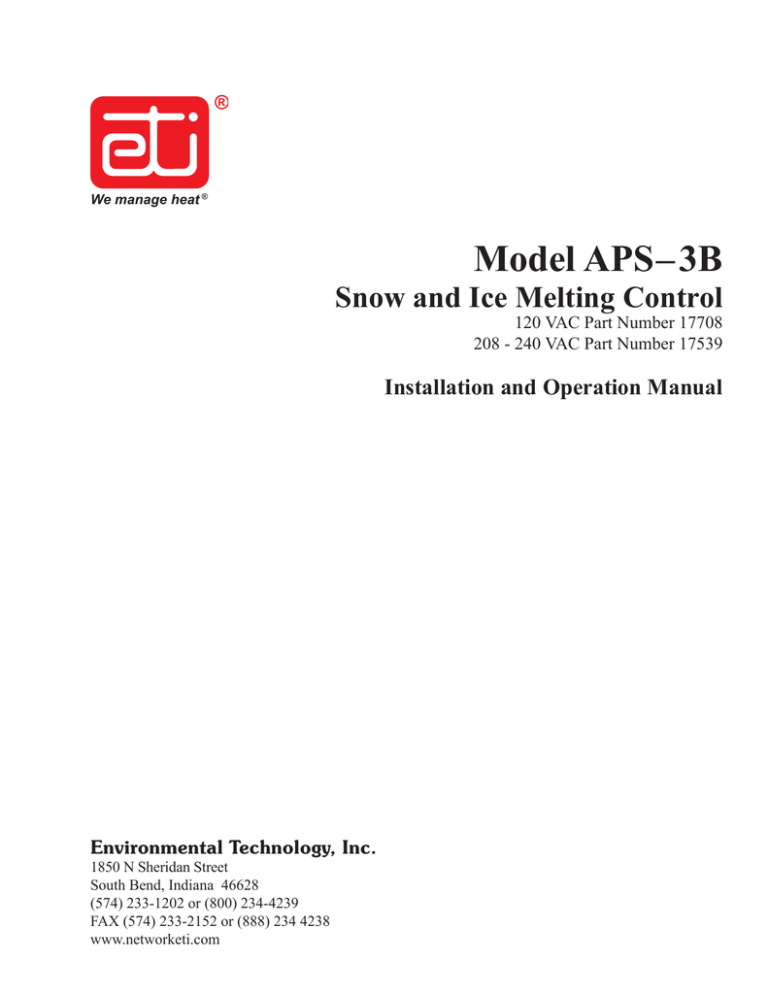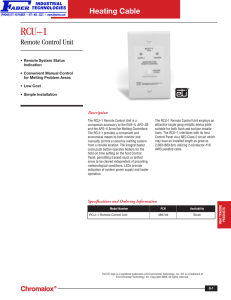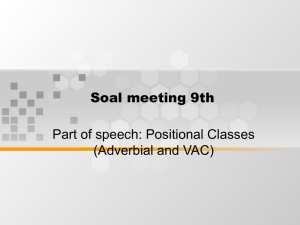
®
We manage heat ®
Model APS–3B
Snow and Ice Melting Control
120 VAC Part Number 17708
208 - 240 VAC Part Number 17539
Installation and Operation Manual
Environmental Technology, Inc.
1850 N Sheridan Street
South Bend, Indiana 46628
(574) 233-1202 or (800) 234-4239
FAX (574) 233-2152 or (888) 234 4238
www.networketi.com
DISCLAIMER
Environmental Technology, Inc. makes no representations or warranties, either expressed or implied, with
respect to the contents of this publication or the products that it describes, and specifically disclaims any
implied warranties of merchantability or fitness for any particular purpose. Environmental Technology,
Inc. reserves the right to revise this publication and to make changes and improvements to the products
described in this publication without the obligation of Environmental Technology, Inc. to notify any person
or organization of such revisions, changes or improvements.
Copyright © 1995, 2004 Environmental Technology, Inc. All rights reserved. No part of this manual may be reproduced or
translated in any form or by any means, electronic or mechanical including photocopying and recording, for any purpose
without the express written consent of Environmental Technology, Inc.
The ETI logo, We Manage Heat, Snow Switch, APS, SC and RCU are registered trademarks of Environmental Technology, Inc.
Printed in USA
PN17702 rev 4/2005
Installation
Install in accordance with the requirements of all applicable electrical and building codes and
regulations.
Enclosure
The APS-3B nonmetallic enclosure is suitable for installation in environments corresponding to NEMA
1, 2, 3R, 12 and 13 applications. The APS–3B was designed to operate satisfactorily over an ambient
temperature range of −40° to 136°F. (−40° to 58°C.).
Using the integral external mounting flanges, the APS–3B is intended to be installed on fixed, vertical,
flat surfaces as it was shipped; no disassembly or component removal is required. The choice of anchors and
companion mounting hardware should be appropriate for both the mounting surface and the environment.
The mounting flanges accommodate a range of fastener diameters up to ¼” (6.35 mm).
Conduit
The APS-3B nonmetallic enclosure is furnished with three ¾” (21 mm) conduit entries to be utilized
in the following manner:
Line voltage (120 VAC or 208 − 240 VAC) supply branch circuit conductors.
Snow/ice melting system load branch circuit conductors or pilot duty
conductors controlling remote contactor(s).
•Top, right:
Low voltage (Class 2) wiring; principally intended for connection of the
selected snow/ice sensor. Also to be used for the Class 2 wiring associated
with both the optional RCU–1 Remote Control Unit.
Prior to finalizing the arrangement and selection of raceways, familiarize yourself with the specific
requirements of both the grounding and wiring sections of these instructions. Should the use of a single
line voltage conduit entry best serve the planned installation, a nonmetallic knockout enclosure has been
furnished, permitting the unused opening to be permanently abandoned. If the APS–3B is to be installed
in a hostile environment, ensure that all conduit terminations are watertight.
•Bottom, right:
•Bottom, left:
Grounding
Effective grounding is key to the safe, proper operation of the APS-3B. Based on the planned
installation, you may elect one (or both) of the following means to accomplish this.
• Provide a continuous copper equipment grounding conductor routed with the branch circuit
conductors.
• Caution: If the branch circuit conductors are contained within continuous rigid metallic
raceway(s), connect a copper bonding jumper to each line voltage race way terminating at
the nonmetallic enclosure using a grounding type bushing or conduit hub or locknut having
approved grounding provisions.
The equipment grounding conductor(s) and/or the bonding jumper(s) are, each, to be properly sized
for the rating of the branch circuit overcurrent protective device employed and shall be terminated in the
mechanical lug designated “G".
1.
Wiring - Line Voltage
Line voltage (120 VAC or 208 − 240 VAC) supply and load branch circuit conductors must be copper
and must have sufficient ampacity to limit the maximum insulation temperature to 60°C. To assist in your
selection of a minimum wire size appropriate for the snow/ice melting system load, see Table 1. (Caution:
For circuits of extraordinary installed length, it may be necessary to utilize larger conductors to minimize
voltage drop.)
Line voltage conductors, #10 AWG and smaller, must be served with appropriate one-hole lugs to
be landed under the #8 binder head terminal screws of both the “Supply” and “Load” barriered terminal
blocks.
Numerous wiring arrangements for the APS–3B are compiled in Appendix A to guide your
installation.
Wiring - Class 2 Low Voltage
The Class 2 low voltage terminal block, shown in Figure 1 below, contains three sets of terminals for,
from top to bottom: Remote Control, Sensor, and Comm Link.
Figure 1. Class 2 low voltage terminal block.
Each of these Class 2 circuits may have an equivalent installed length of 2,000 feet (609.5 mm) utilizing
multiconductor #18 AWG jacketed cable. For distances exceeding this length, contact Environmental
Technology Customer Service for assistance.
Proper automatic operation of the APS–3B requires the connection of at least one snow/ice sensor,
color matching the sensor lead wires to the respective terminals as shown (blk-blk, wht-wht, red-red).
Systems employing multiple sensors should be connected in parallel in whatever fashion may conveniently
accommodate the planned installation; it is unnecessary to wire radially to each sensor. For guidance
in physically installing a specific snow/ice sensor, consult the Installation Instructions for the selected
model.
If the system incorporated an (optional) RCU–1 Remote Control Unit, it is un-necessary to discriminate
between the two required conductors when terminating. See the Installation Instructions for the unit
regarding specific installation requirements.
Upon completing all line and low voltage and grounding terminations, and prior to energizing the
APS–3B, reinstall the deadfront metal compartment cover.
2.
Checkout
Thoroughly check the system before placing it in service. Our experience shows that installation
errors cause the majority of problems. Frequently encountered problems include wiring errors. Simple
electrical tests and visual inspections identify these problems.
Once the APS–3B installation has been properly completed, it may be energized. (Note: If the snow/ice
melting system is comprised of one or more SC–40 Satellite Contactors, energization will entail the closing
of multiple branch circuit overcurrent protective devices.) The green “Supply” LED will be illuminated
on each successive unit as its respective supply circuit is energized; the RCU–1 Remote Control Unit LED
display, if a part of the system, operates in tandem with the APS–3B.
Should any individual momentary contact “Heater Cycle” push button be held depressed, all LEDs
will flash, continuously, at one second intervals until the “offending” push button is released.
Once weather tracking has begun, should any installed sensor detect snow/ice, the amber “Snow”
LED on the APS–3B will be illuminated. Subsequently, the APS–3B will initiate operation of the snow/ice
melting system, this being signaled by its amber“ Heater” LED and the companion display on the RCU–1
Remote Control Unit (if a part of the system). Similarly, the amber “Heater” LED on all installed SC–40
Satellite Contactors having an energized power supply will be illuminated as each initiates its respective
snow/ice melting system load.
The APS–3B “Hold-On Time” adjustment, having a range of 0 to 10 hours, may be employed for the
following purposes:
•
•
To maintain snow/ice melting function for a selected time duration, beginning when all
installed sensors concur that snowfall has ceased. This, for example, ensures complete clearing and drying of such sensitive locations as ramps for the physically challenged, or permits
effective clearing of zones regularly experiencing excessive drifting, slush deposition or
similar anomaly. An initial setting of 3 hours is suggested; for enhanced effectiveness and/or
economy, this setting may be altered based upon operational experience.
To manually energize the snow/ice melting system for a selected time duration by depressing
the APS–3B “Heater Cycle” push button for (at least) 3 seconds and releasing. This mode is
most useful as an annual, pre-season, operational test of the snow/ice melting system or as a
diagnostic aid in troubleshooting. If the outdoor temperature is sufficiently cold, the system
will be continuously energized for the selected time duration. This mode may be duplicated
utilizing the “Heater Cycle” push button on the remote control accessory, if present in the
system.
If you experience installation problems or have any question regarding proper installation procedures,
Environmental Technology Customer Service is available for assistance during normal business hours,
8: 00 am to 4: 00 pm, EST. Phone (800) 234-4239. Fax (574) 233-2152.
3.
Appendix A
APS–3B Wiring Diagrams
I.
Pilot Duty
A. Mechanically-Held Contactor(s)
1. 120 VAC Coil(s) . . . . . . . . . . . . . . . . . . . . . . . . . . . . . . . . . . . . Figure A–1
2. 208 − 240 VAC Coil(s) . . . . . . . . . . . . . . . . . . . . . . . . . . . . . . . . Figure A–2
B. Electrically-Held Contactor(s)
1. 120 VAC Coil(s) . . . . . . . . . . . . . . . . . . . . . . . . . . . . . . . . . . . . . Figure A–3
2. 208 − 240 VAC Coil(s) . . . . . . . . . . . . . . . . . . . . . . . . . . . . . . . Figure A–4
II.
Switching Duty
A. 120 VAC — One 30A (or smaller) Branch Circuit . . . . . . . . . . . . . . . . Figure A–5
B. 208 − 240 VAC — One 30 A. (or smaller) Branch Circuit . . . . . . . . . . Figure A–6
APS-3B
Snow/Ice Melting Controller
SUPPLY
SNOW
HEATER
HEATER CYCLE
4
5
6
3
7
2
8
1
9
0
10
HOLD-ON TIME (HRS)
Environmental Technology, Inc.
South Bend, Indiana USA
(800) 234-4239
C2
UNLATCH
LATCH
L1 L2 N
NC
NO
NO
NC
L2
L2
L1
L1
LATCH
G
UNLATCH
C1
SUPPLY
120 VAC 50/60 Hz
Figure A-1: Pilot Duty - Operating mechanically-held contactors with 120V coils.
APS-3B
Snow/Ice Melting Controller
SUPPLY
SNOW
HEATER
HEATER CYCLE
4
5
6
3
7
2
8
1
9
0
10
HOLD-ON TIME (HRS)
Environmental Technology, Inc.
South Bend, Indiana USA
(800) 234-4239
C2
UNLATCH
LATCH
NC
NO
NO
NC
NO CONNECTION
L1 L2
L2
L2
L1
L1
LATCH
G
UNLATCH
C1
SUPPLY
208 - 240 VAC
50/60 Hz
Figure A-2: Pilot Duty - Operating mechanically-held contactors with 208V or 240V coils.
APS-3B
Snow/Ice Melting Controller
SUPPLY
SNOW
HEATER
HEATER CYCLE
4
5
6
3
7
2
8
1
9
0
10
HOLD-ON TIME (HRS)
Environmental Technology, Inc.
South Bend, Indiana USA
(800) 234-4239
C2
L1 L2 N
NC
NO
NO
NC
L2
L2
L1
L1
G
C1
SUPPLY
120 VAC 50/60 Hz
Figure A-3: Pilot Duty - Operating electrically-held contactors with 120V coils.
APS-3B
Snow/Ice Melting Controller
SUPPLY
SNOW
HEATER
HEATER CYCLE
4
5
6
3
7
8
2
1
9
0
10
HOLD-ON TIME (HRS)
Environmental Technology, Inc.
South Bend, Indiana USA
(800) 234-4239
C2
NC
NO
NO
NC
NO CONNECTION
L1 L2
L2
L2
L1
L1
G
C1
SUPPLY
208 - 240 VAC
50/60 Hz
C1
NC
NO
NO
NC
NO CONNECTION
L1 L2
L2
L2
L1
L1
G
SUPPLY
208 - 240 VAC
50/60 Hz
Figure A-4: Pilot Duty - Operating electrically-held contactors with 208V or 240V coils.
APS-3B
Snow/Ice Melting Controller
SUPPLY
SNOW
HEATER
HEATER CYCLE
4
5
6
3
7
2
8
1
9
0
10
HOLD-ON TIME (HRS)
Environmental Technology, Inc.
South Bend, Indiana USA
(800) 234-4239
HEATER 2
L1 L2 N
NC
NO
NO
NC
L2
L2
L1
L1
G
HEATER 1
SUPPLY
120 VAC 50/60 Hz
Figure A-5: 120V Switching Duty - Operating one 30 A (or smaller) branch circuit.
Combined heater load may not exceed 24A
APS-3B
Snow/Ice Melting Controller
SUPPLY
SNOW
HEATER
HEATER CYCLE
4
5
6
3
7
8
2
1
9
0
10
HOLD-ON TIME (HRS)
Environmental Technology, Inc.
South Bend, Indiana USA
(800) 234-4239
HEATER 1
NC
NO
NO
NC
NO CONNECTION
L1 L2
L2
L2
L1
L1
G
SUPPLY
208 - 240 VAC
50/60 Hz
HEATER 2
NC
NO
NO
NC
NO CONNECTION
L1 L2
L2
L2
L1
L1
G
HEATER 1
SUPPLY
208 - 240 VAC
50/60 Hz
Figure A-6: 208V or 240V Switching Duty - Operating one 30 A (or smaller) branch circuit.
Combined heater load may not exceed 24A



